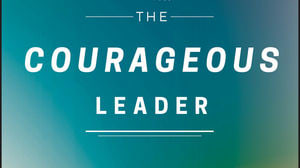Leadership—the kind that motivates, inspires and delivers—takes courage. And the more you exercise courage, the stronger leader you become, according to Angela Sebaly, co-founder and CEO of Personify Leadership and author of The Courageous Leader (Wiley, 2017). Sebaly has more than 20 years' experience in leadership development working with thousands of leaders around the world. Her book shows readers how to exercise courage in everyday situations to build the unshakeable foundation of a great leader by:
- Moving beyond your comfort zone.
- Developing your ability to focus through tough times.
- Tapping into your natural courage and honing your leadership ability.
- Leveraging your strength in situations large and small.
The HR Magazine Book Blog recently spoke with Sebaly about her book.
Many books on leadership address the vital role courage plays. What sets your book apart?
There are a number of books on courage, and who better to tell us about courage than Colin Powell and others who have faced dramatic, life-threating situations or other global calamities? The Courageous Leader is different in that it tells the story of the seemingly unimportant acts of courage that, if left undone, lead to much larger problems down the road. In this way, it tells the story of everyday courage, the kind of courage we are all able to offer our teams and organizations and the possibility it brings when we do.
How does courage separate a good manager from an exceptional leader? What roles do diversity, pain and choice play in creating the difference?
The risk of being courageous is that we will feel discomfort and pain. The risk of not being courageous is that we fall short of achieving our greatest potential. The choice is ours as to whether we take the risk or not. We can stay in the comfortable place where courage is not needed. When we choose to embrace courage, we have many options. That's the role diversity plays. It isn't just going into a burning building. Courage presents itself in many ways and can be leveraged in a whole host of situations, such as taking tough stands, delegating, receiving difficult feedback and chasing our dreams.
One surprising revelation from your book is that there are components of leadership that require more courage than others. What skills have courageous leaders honed especially well?
The most important skill a courageous leader has honed is the ability to move to action in the face of discomfort or pain. On a scale of 1 to 10, we are all faced with discomfort or pain at some point in leadership. It's just a normal part of the job. If we shy away from this discomfort or pain and we don't act, we send the message to others that less than desirable performance or unacceptable behaviors are OK in our organization. It's only when we act in the face of discomfort or pain that we are acting courageously.
How can HR leaders face daunting challenges, such as changing entrenched cultures or meaningfully influencing C-suite decisions, with the courage your book highlights?
An HR leader who is willing to do the tough stuff in the face of discomfort or pain is far more influential than his or her counterparts or C-suite executives. In the book, I provide tangible tools for overcoming the things that keep us from being courageous and for developing the strength to be more influential. Let's take values, for example. If HR professionals are not clear about where they stand on tough issues, they will be likely to fight every battle that comes their way, losing credibility and draining their energy in the process. But if they are clear about their values and the values of the organization they serve, then when a tough message needs to be delivered, they will know how to prioritize their energy and take the necessary steps.
How can aspiring leaders "lean in" to their fears in order to face any challenge?
In the book, I start with the fact that all humans fear discomfort and pain to some degree or another. If we can start with this basic understanding, then we can choose to free ourselves from the fear that limits our effectiveness, like the fear of giving tough feedback, and instead honor the fear that is meaningful and useful. Half the battle is knowing that it is OK to feel discomfort and pain. Even those individuals who make it look easy are feeling it whether or not it is evident to others.
Matt Davis is the manager of book publishing at SHRM.
Advertisement
An organization run by AI is not a futuristic concept. Such technology is already a part of many workplaces and will continue to shape the labor market and HR. Here's how employers and employees can successfully manage generative AI and other AI-powered systems.
Advertisement



